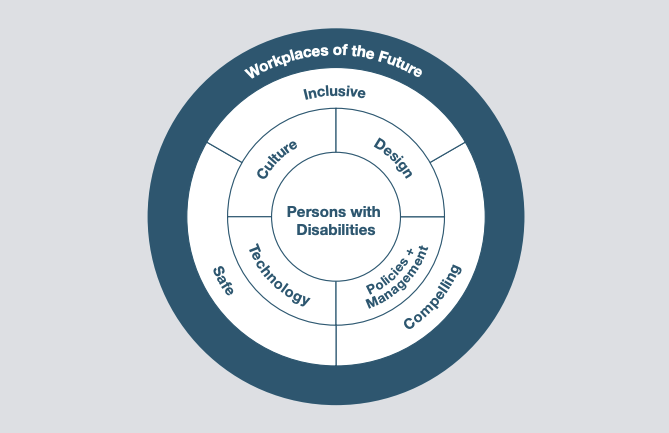With the workplace in a state of transformation post-Covid, never has there been a better time to take a closer look at how the workplace can address the needs of people with varying abilities.
There are more than 1.3 billion people worldwide with a disability of some kind, be it physical, mental, intellectual or sensory, and the workplace must welcome and include every individual in order to be both productive and profitable.
A new blueprint from Steelcase and G3ict (Global Initiative for Inclusive Information and Communication Technologies) aims to provide organisations with a vision for a more inclusive future.
The Blueprint for Inclusive Workplaces of the Future
“Workplaces of the future must be compelling destinations where every team member can contribute - not despite their unique identities - but because of them.”
During the first six months of 2021, Steelcase and G3ict partnered on a project to understand how workplaces around the world should evolve to be inclusive, safe and compelling for all.
The three pillars of the future workplace:
-
Inclusive - all individuals are treated fairly and respectfully, have equal access to opportunities and resources, and contribute fully to the organisation’s success
-
Safe - the environment should encompass all factors that impact the safety, health and wellbeing of employees
-
Compelling - the workplace must promote people’s strengths, capabilities and functioning, in order to achieve high levels of engagement, productivity, satisfaction and retention
The blueprint serves as a resource for understanding the factors that shape workplaces, creating a platform for stakeholder engagement and presenting actions for creating a more inclusive workplace.
The project focused on persons with disabilities, which the researchers defined as “those people who have long-term physical, mental, intellectual or sensory impairments which in interaction with various barriers may hinder their full and effective participation in society on an equal basis with others.”
Research included a literature review, a global survey, roundtable sessions and individual qualitative interviews.
Key insights
The global survey, conducted in 28 countries including the UK revealed:
- Only 49% of people say their industry has a clear and shared understanding of an inclusive workplace (compared to 64% for safe, and 53% for compelling).
- Those who identified as having a disability (20%) were less sure their industry has a clear and shared understanding of an inclusive workplace (44% of persons with disabilities vs 51% of those without disabilities)
“Considerations of accessibility and usability of physical spaces and digital tools in the workplace continue to lag behind the needs and expectations of persons with disabilities, contributing to a level of exclusion.”
The top three elements of an inclusive workplace are identified as:
- 61% - Representation + diversity across all functions and levels
- 45% - Accessible products, technology + systems
- 45% - Accessible physical space
Those with disabilities placed more importance on accessible technology and space above representation. This highlights how important the lens of the disability community is for creating inclusive, safe and compelling workplaces.
The primary outcomes of an inclusive workplace are identified as:
- 80% - Increased employee satisfaction
- 65% - Increased innovation
- 53% - Increased productivity for individuals and teams
As well as data, the blueprint includes:
- Concept map identifying opportunities and challenges in the workplace
- Stakeholder map organising primary stakeholders by groups that represent their common roles and the contributions they can make to inclusive workplaces
- Ecosystem map demonstrating the behaviours of the stakeholders in relation to each other and identifying tangible actions each group can take to shape inclusive workplaces

Practical recommendations are made for each stakeholder group, from employees to senior leaders to facilities managers. Examples include:
- Giving all employees choice and control how, when and where they work
- Senior leaders actively sponsoring initiatives that support inclusion in the workplace
- Facilities managers responding to and supporting the goals and values of organisations relative to inclusion, safety and employee engagement.
The way forward
“We know there is a lot more work to be done and we hope this blueprint helps to chart a positive path forward.”
The pandemic has reminded us of the value of individual staff members, and of their importance in the productivity and profitability of any company.
The blueprint has been made publicly available in an attempt to advance the conversation around how to create inclusive, safe and compelling workplaces.









